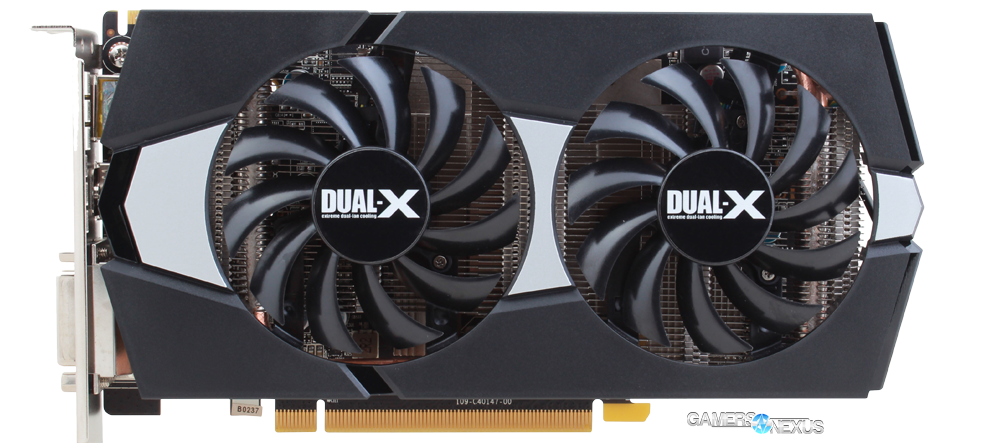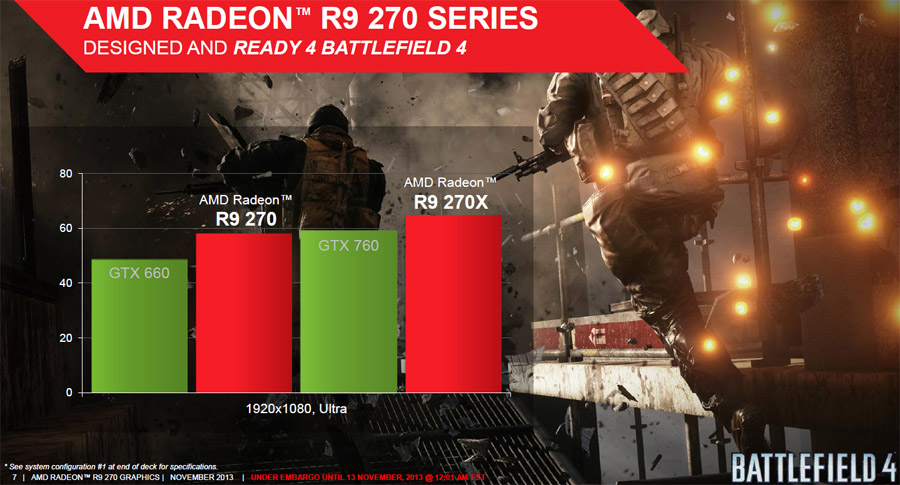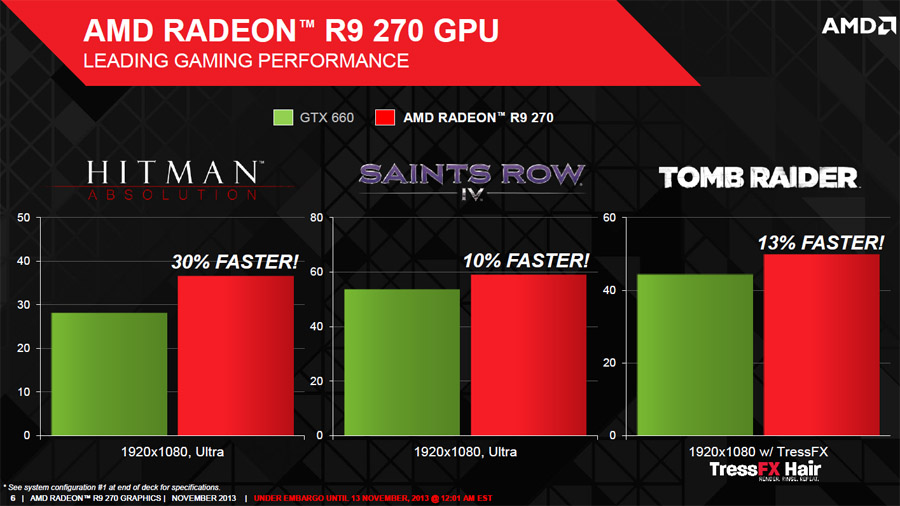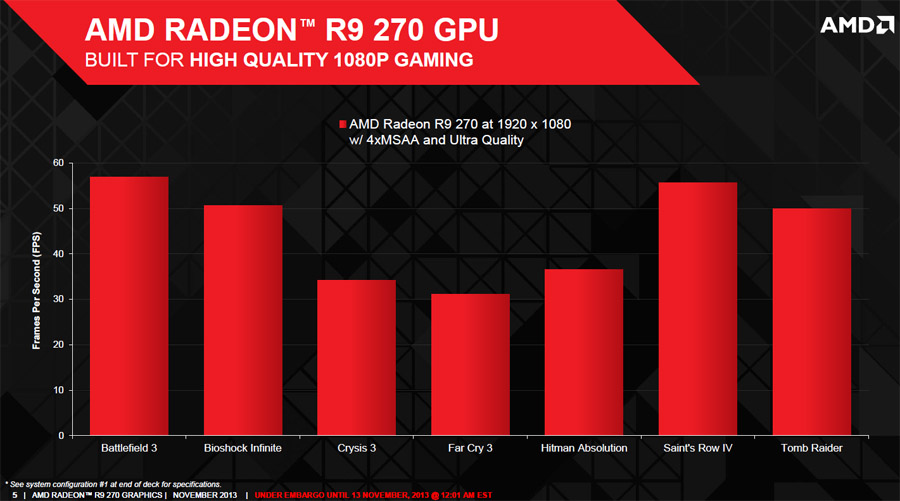After our coverage of nVidia's GTX 780 Ti -- a $700 enthusiasts-only monster -- we turn now to AMD for a reality-check. For nearly a full year now, we've been recommending AMD's 7850 and nVidia's GTX 650 Ti Boost in the low-end, and given all the shifting of the high-end market, those suggestions have remained stable. We won't see nVidia's entry-level cards until next year, but AMD isn't waiting around: they've announced the R9 270, a card that aims to compete with existing mid-range cards at a significantly lower price-point.
We'll cover the AMD R9 270 specs, price, and preliminary benchmarks against the 7850 and GTX 760 below; new information on the Never Settle Bundle is also included.
AMD Radeon R9 270 Specifications & Price
| Spec/Card | R9 290X | R9 280X | R9 270X | R9 270 | R7 260X |
| GPU | Hawaii | Tahiti XT | Pitcairn | Pitcairn | Bonaire XTX |
| Fab Process | 28nm | 28nm | 28nm | 28nm | 28nm |
| Transistor Count | 6.2B | 4.3B | 2.8B | 2.8B | 2.8B |
| Stream Processors | 2816 | 2048 | 1280 | 1280 | 896 |
| ROP/TMUs | 64/176 | 32/128 | 32/80 | 32/80 | 16/56 |
| Core/Boost Clock | 800MHz / 1000MHz | 1000MHz / 1050MHz | 1000MHz / 1050MHz | 900MHz / 925MHz | 1100MHz |
| Memory Config | 4GB GDDR5 512-bit | 3GB GDDR5 384-bit | 2GB GDDR5 256-bit | 2GB GDDR5 256-bit | 2GB GDDR5 128-bit |
| Memory Clock | 5Gbps | 6Gbps | 5.6Gbps | 5.6Gbps | 6.5Gbps |
| Price | $560 | $300 | $200 | $180 | $140 |
The R9 270's MSRP of $180 makes it a direct upgrade from the 7850 or GTX 650 Ti Boost, and puts it in more immediate competition with the $250 GTX 760. AMD's Radeon R9 270 is available online now.
AMD's Market Position & Streamlining Game-Hardware Optimization
 AMD's position in the market has solidified over the past year, as evidenced by their tremendous increase in market value. A lot of this is with thanks to their next-gen console integration (I wrote an analysis of this over here), and according to AMD's recent R9 270 press materials, it appears that the company hopes to leverage their console proliferation in the PC world. As I analyzed in the linked post, PC hardware's capabilities far-and-away exceed the performance yielded in games; this is because optimization is always a limitation on the software stack, meaning that sub-optimal code will underutilize the hardware present.
AMD's position in the market has solidified over the past year, as evidenced by their tremendous increase in market value. A lot of this is with thanks to their next-gen console integration (I wrote an analysis of this over here), and according to AMD's recent R9 270 press materials, it appears that the company hopes to leverage their console proliferation in the PC world. As I analyzed in the linked post, PC hardware's capabilities far-and-away exceed the performance yielded in games; this is because optimization is always a limitation on the software stack, meaning that sub-optimal code will underutilize the hardware present.
With consoles, developers have more direct access to the metal and have a single subset of hardware to develop upon. There are thousands of component combinations for gaming PCs (just look at our PC build guides), and so software development suddenly becomes infinitely more complex and challenging. Ultimately, developers have to pick the most prevalent configurations to support most heavily.
AMD hopes to streamline the optimization process for game developers by offering a more unified architecture between their GPUs and APUs. The company's Graphics Core Next (GCN) architecture has been around for a little while now, and without getting into too much depth, it's built to improve GPU utilization in times of low-load. If GCN's integrated PowerTune technology detects that the GPU's power consumption-to-performance is sub-optimal, it'll bolster the clockspeed to better make use of the full power availability and theoretical maximum throughput. Battlefield is a real-world example of a game that can communicate with GCN to optimize the graphics capabilities in real-time. Theoretically, this will help optimize PC performance of games developed for consoles. More on GCN here.
AMD Radeon R9 270 Analysis - Reclaiming the Sub-$200 Video Card Market
Let's look at the R9 more specifically.
AMD's R9 is marketed to users who hover between the budget and mid-range cards; priced at $180 and performing below the 760, 7950, and 270X, but above the 650 Ti Boost, GTX 660, and 7870, the R9 270 lands firmly in the middle of the price spectrum.
On a specifications level, the 270 offers better hardware than the 7870 (making for a replacement at a little over half the launch price) and significantly better hardware than the 7850. The $200 270X sports a higher-frequency core clock and boost clock and tends to be closer in performance to the GTX 760.
AMD has branded the 270 as "the best 150W TDP GPU for 1080p gaming." If you're building a system in the $600-$850 range, your choice are basically limited to the following cards:
- AMD 7850 2GB (~$110)
- GTX 650 Ti Boost 2GB (~$120)
- AMD R9 270 2GB (~$180)
- GTX 660 2GB (~$180)
- AMD 270X 2GB (~$200)
Given these options, we can confidently say that the low-end selection (GTX 650 TiB vs. AMD 7850) is a toss-up, and will hinge on what games you're playing. The mid-range options (AMD R9 270 vs. GTX 660) is handily won by the R9 270. The uppermost range of our price guideline is really dominated entirely by the 270X, with nVidia's next closest competitor (the 760) priced at a full $50 more on average.
In short, what I'm saying is that AMD indisputably owns the $100-$200 video card market right now.
Here are a couple of AMD's internal benchmarks for the R9. The specs on the test machine were listed as: i74960X, ASUS Sabertooth X79, 16GB DDR3-1900 9-9-9-24, Win7 64-bit.
AMD Radeon R9 270 vs. GTX 760 Battlefield 4 Benchmark
AMD Radeon R9 270 Gaming Benchmarks
New AMD Never Settle Bundle - One Year Anniversary
One year after the initial launch of AMD's "Never Settle" game bundle, we see a refresh of the available games and relevant cards. The free game bundle update sees the inclusion of Battlefield 4 with AMD Radeon R9 series video cards and Thief with the purchase of an R7 260X or higher video card.
And with that, I'll wrap-up this AMD coverage and point you toward our new $425 ultra-budget gaming PC guide, which utilizes an AMD APU for lightweight gaming (like LoL).
- Steve "Lelldorianx" Burke.




